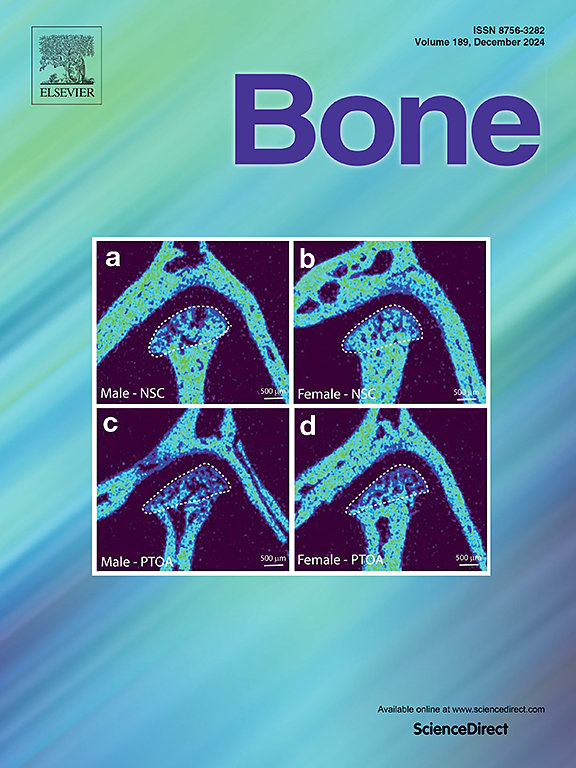Use of double-echo ultrashort echo time magnetic resonance imaging to assess proximal femoral cortical bone changes in axial spondyloarthritis
IF 3.5
2区 医学
Q2 ENDOCRINOLOGY & METABOLISM
引用次数: 0
Abstract
Objective
We quantitatively evaluated proximal femoral cortical bone changes associated with generalized bone loss in axial spondyloarthritis (axSpA) patients using double-echo ultrashort echo time (UTE) MRI. To achieve non-radiation, clinically available visualization of cortical microstructural deterioration in the proximal femur of axSpA and to determine the factors influencing it.
Materials and methods
Patients with axSpA (n = 83) and age- and sex-matched healthy controls (n = 61) were recruited and underwent double-echo UTE MR scan of the nondominant proximal femur. Porosity index (PI) and cortical bone thickness (CbTh) were measured by two radiologists and their average measurements were used for subsequent analyses. Additionally, demographic characteristics of all subjects and disease-specific characteristics of axSpA patients were recorded. Proximal femoral cortical bone PI and CbTh values were compared between axSpA patients and healthy controls using independent samples t-test. Correlation analyses (Pearson or Spearman or Point-biserial correlation coefficients) were conducted to investigate factors potentially associated with UTE measurements in axSpA patients, and Bonferroni correction was applied at the α = 0.002 level for more stringent correction. Multiple linear regression analyses were performed to further identify influencing factors of UTE measurements with multiple correlated variables.
Results
A total of 72 axSpA patients and 52 healthy control subjects were finally included. Patients and control subjects were comparable in sex, age, and body mass index (BMI). Proximal femoral cortical PI was higher (p < 0.001) and CbTh was lower (p < 0.001) in axSpA patients than in healthy controls. Sex (p < 0.001), BMI (p = 0.003), disease duration (p = 0.044), onset age (p = 0.01), alkaline phosphatase (ALP) (p < 0.001), radiographic axSpA (r-axSpA) (p = 0.02), Sacroiliac Joint Structural Score (SSS)-backfill (p = 0.03), SSS-ankylosis (p = 0.01), and nonsteroidal anti-inflammatory drugs (NSAIDs) use (p = 0.03) were potentially correlated to proximal femoral cortical PI, and among them, sex (p < 0.001) and BMI (p = 0.01) were independently associated demographic characteristics, and ALP (p = 0.02), SSS-backfill (p = 0.044) and SSS-ankylosis (p = 0.01) were independently associated disease-specific characteristics, and when all types of variables were considered, sex (p < 0.001), BMI (p = 0.016), and SSS-ankylosis (p = 0.042) were independently associated with PI. BMI (p = 0.043) and NSAIDs use (p = 0.041) were potentially negatively associated with CbTh.
Conclusion
Double-echo UTE measurements revealed deteriorated proximal femoral cortical bone microstructure in axSpA patients than controls, potentially associated with sex, BMI, disease duration, onset age, ALP, r-SpA, SSS-backfill, SSS-ankylosis, and NSAIDs use, where sex, BMI, ALP, SSS-backfill and SSS-ankylosis were the independently relevant factors. It offers a novel tool for axSpA's cortical bone assessment.
利用双回波超短回波时间磁共振成像评估轴型颈椎病股骨近端皮质骨改变
目的利用双回波超短回波时间(UTE) MRI定量评价轴型颈椎病(axSpA)患者股骨近端皮质骨改变与广泛性骨质流失的相关性。为了实现无放射、临床可用的axSpA股骨近端皮质显微结构恶化的可视化,并确定其影响因素。材料和方法招募患有axSpA的患者(n = 83)和年龄和性别匹配的健康对照(n = 61),并对非显性股骨近端进行双回波UTE MR扫描。由两名放射科医生测量孔隙度指数(PI)和皮质骨厚度(CbTh),并将其平均值用于后续分析。此外,还记录了所有受试者的人口统计学特征和axSpA患者的疾病特异性特征。采用独立样本t检验比较axSpA患者与健康对照组股骨近端皮质骨PI、CbTh值。进行相关分析(Pearson或Spearman或点双列相关系数)以调查可能与axSpA患者UTE测量相关的因素,并在α = 0.002水平上应用Bonferroni校正以进行更严格的校正。采用多元线性回归分析,通过多相关变量进一步确定UTE测量的影响因素。结果最终纳入72例axSpA患者和52例健康对照。患者和对照组在性别、年龄和身体质量指数(BMI)方面具有可比性。股骨近端皮质PI较高(p <;0.001), CbTh更低(p <;0.001)。性(p <;0.001)、BMI (p = 0.003)、病程(p = 0.044)、发病年龄(p = 0.01)、碱性磷酸酶(ALP) (p <;0.001), x线axSpA (r-axSpA) (p = 0.02),骶髂关节结构评分(SSS)-回填(p = 0.03), SSS-强直(p = 0.01)和非甾体抗炎药(NSAIDs)的使用(p = 0.03)与股骨近端皮质PI有潜在的相关性,其中,性别(p <;0.001)和BMI (p = 0.01)是独立相关的人口学特征,ALP (p = 0.02)、sss -回填(p = 0.044)和sss -强直(p = 0.01)是独立相关的疾病特异性特征,当考虑所有类型的变量时,性别(p <;0.001)、BMI (p = 0.016)和sss -强直(p = 0.042)与PI独立相关。BMI (p = 0.043)和使用非甾体抗炎药(p = 0.041)与CbTh呈潜在负相关。结论超声双回声测量显示,axSpA患者股骨近端皮质骨微结构较对照组恶化,与性别、BMI、病程、发病年龄、ALP、r-SpA、sss -充填、sss -强直及使用非甾体抗炎药有关,其中性别、BMI、ALP、sss -充填、sss -强直是独立相关因素。它为axSpA的皮质骨评估提供了一种新的工具。
本文章由计算机程序翻译,如有差异,请以英文原文为准。
求助全文
约1分钟内获得全文
求助全文
来源期刊

Bone
医学-内分泌学与代谢
CiteScore
8.90
自引率
4.90%
发文量
264
审稿时长
30 days
期刊介绍:
BONE is an interdisciplinary forum for the rapid publication of original articles and reviews on basic, translational, and clinical aspects of bone and mineral metabolism. The Journal also encourages submissions related to interactions of bone with other organ systems, including cartilage, endocrine, muscle, fat, neural, vascular, gastrointestinal, hematopoietic, and immune systems. Particular attention is placed on the application of experimental studies to clinical practice.
 求助内容:
求助内容: 应助结果提醒方式:
应助结果提醒方式:


